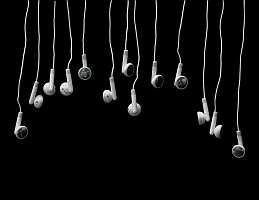 Engineers at Asius Technologies in Longmont, Colorado have found what they believe is the cause of listener fatigue brought on by on-ear headphones and hearing aids. Their findings, along with suggested fixes, were presented this past weekend at a meeting of the Audio Engineering Society in London, U.K.
Engineers at Asius Technologies in Longmont, Colorado have found what they believe is the cause of listener fatigue brought on by on-ear headphones and hearing aids. Their findings, along with suggested fixes, were presented this past weekend at a meeting of the Audio Engineering Society in London, U.K.
The problem concerns the discomfort and pain some people experience while using in-ear headphones, hearing aids, and other devices that seal the ear canal from external sound. Stephen Ambrose, Robert Schulein, and Samuel Gido of Asius Technologies describe how these devices seal a speaker in the ear canal, which creates an oscillating pressure chamber that can boost sound pressure levels.
In one paper, the authors called the effect Trapped Volume Insertion Gain (TVIG), which they found through numerical modeling and direct measurements. Their data suggest that TVIG triggers the acoustic reflex, a defense mechanism in the ear that dampens the transfer of sound energy from the eardrum to the cochlea by as much as 50 decibels.
Yet the ear drum is still not protected from the excessive shaking. The resulting physical strain, along with the repeated activation of the tiny muscles involved in the acoustic reflex, are what the researchers believe contributes to listener fatigue.
The Asius engineers recommended two fixes for the problem, one a retrofit on existing devices and the other a separate new device. Earlier work on sealed in-ear devices led to small holes in the seal to relieve the pressure, which in turn led to problems with squeaking feedback or lower sound quality.
The retrofit approach adds a thin medical-grade polymer membrane over the holes that reseals the device, but also absorbs the pressure. The authors say the retrofit appears to eliminate the overpressure effects that impact the users of many headphones, hearing aids and other devices.
The new device developed to alleviate the pressure is a more advanced corrective device by Asius, a small, inflatable seal called an Ambrose Diaphonic Ear Lens (ADEL). The device uses Asius’s diaphonic pump to to inflate the polymer membrane inside ADEL.
The diaphonic pump converts the alternating, compression-expansion waves of sound into a direct-flowing stream of molecules, filling the membrane with minimal energy from the headphone speaker. The pump has enough force to both inflate the ear lens and keep the device comfortably in the ear canal for as long as the device is worn.
Asius developed the diaphonic pump with support from a National Science Foundation Small Business Innovation Research grant. An international patent for the technology has also been awarded.
Photo: Alosh Bennett/Flickr
* * *

 RSS - Posts
RSS - Posts
[…] Read more: Cause of Headphone, Hearing Aid Fatigue Diagnosed […]